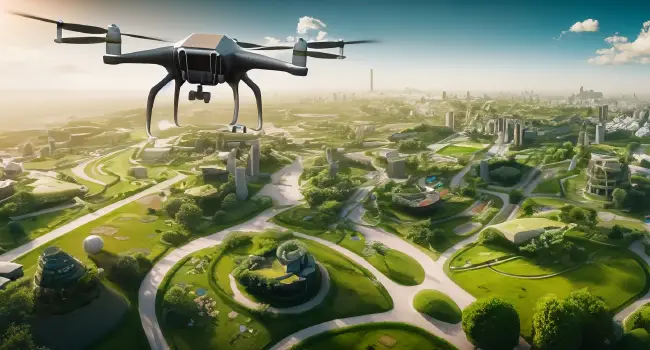Drones

A drone, also known as an Unmanned Aerial Vehicle (UAV), is a craft without a human on board. Some drones are controlled remotely by a person, others can fly completely on their own.
Drones have many applications, including military, research, recreation, agriculture, surveillance, deliveries, photography, search and rescue, underwater exploration, selfie drones, toy drones, racing drones and more.
In the near future, drones could play a vital role in air travel, medical transportation, disaster relief, environmental conservation, and many other fields. However, the use of drones must be regulated carefully to ensure the safety and privacy of individuals are protected.
Types of aerial drone platforms
The three main drone types are Multi-Rotor, Fixed-Wing and VTOL (Vertical Take-Off and Landing).
What makes up a drone?
Body and Frame - the frame and body are usually made of lightweight but sturdy material. The frame holds the parts and the body protects the parts.
Electronics – the main electronics manages the system. A drone may also have motor controllers, speed controllers, flight controllers, power distribution boards, communication circuits, GPS Modules, and/or camera controls.
Power – most drones use rechargeable batteries. Micro drones may only have enough charge for a short flight. Long distance drones may use solar power or hydrogen fuel to recharge batteries in the air.
Motors – for smaller drones, coreless (brushed) motors are common. For larger drones, more expensive brushless motors are used for their efficiency and decreased noise level.
Propellers – props may look similar, but small differences in shape and angle make a big difference. This site is a good reference I found on drone propellers.
Cameras – Aside from providing a unique and fun perspective, drone cameras are becoming indispensable tools for surveying land, bridge inspection, real estate sales, and many other applications. A camera drone moving around a statue or building can create a 3d model of the object using photogrammetry, the science of making measurements from photographs
Sensors – sensors can be mounted on a drone that detect heat, chemicals, radiation, and air quality. Lasers mounted to a drone can create 3d models of large objects.
Adding batteries or fuel to a drone increases the weight and provides a longer flight time. Larger motors and props can carry more but will drain the batteries quicker. Using more efficient or faster charging batteries could increase the price. It can be a juggling act for drone designers and consumers choosing the best price, run time, and payload.
Autonomy - Fully autonomous drones can takeoff, complete a misson, and land on their own. Basic autonomy is created from cameras, sensors and artificial intelligence. Advanced autonomy calls for situational awareness and knowledge about the environment surrounding the aircraft.
Pros and Cons of Drones
Advantages
There is a large list of applications where drones are a great fit, and sometimes better at a task than the current technology.
There many different types and sizes of drones that can be developed for an application.
Pilots are not in danger.
Can be easy to learn to fly.
Efficient in getting from point A to point B.
Takes a good photo, from a different perspective.
Can get to places that are hard to reach for people.
Battery powered lowers risk of explosion
Disadvantages
Poses risk to other aircraft, birds.
Poses risk to humans and property when they fall from the sky.
They break easily.
They can get lost or fall in the water.
They are noisy.
You can’t fly them in certain areas.
Most have a limited range.
Does not perform well in wind or rain.
Privacy issues
Next up: Military Drones
Drone Articles and Web Sites
I search the internet daily for new articles from around the world that interest me or I think will interest you. My hope is that it saves you time or helps students with their assignments. Listed by most recent first, dating back to 2005.
-
Guinness World Record for most drones launching fireworks simultaneously video
-
Drone mother ship can release mini-drone swarms for use in search and rescue video
-
Heavy-lift drones are flying cargo to offshore wind turbines in 4 minutes from Electrek
-
U.S. Commercial Drone Delivery Comes Closer from IEEE Spectrum
-
Drone delivery's biggest problem isn't in the air from Axios
-
Best Drone Photo in SkyPixel Contest from PetaPixel
-
These Drones Beat First Responders to the Scene from IEEE Spectrum
-
Drones Deliver Defibrillators Faster Than Ambulances from IEEE Spectrum
-
Manchester University claims huge drone record from BBC News
-
'That Was Insane!' AI Quadcopter Dethrones Top Human Drone Racers from Gizmodo
-
This tiny drone can pollinate crops to help overworked bees from DroneDJ
-
This Drone Can Fly, Float, and Roll to Get Around from IEEE Spectrum
-
Statue of Liberty comes to life in New York drone show from ABC News
-
A heat-resistant drone that can fly into fires from Advanced Science News
-
The Portuguese drone that douses wildfires from above from BBC Future
-
MIT-founded drone company launches home delivery service in Norway from DroneDJ
-
Drone flies 77 miles nonstop in Texas from DroneDJ
-
Aerial Drone Competition website
-
Morpho: the hybrid fixed-wing multi-rotor drone can use wind in its favor from Interesting Engineering
-
DroneUp testing new hydrogen fuel cell technology for drones from DroneDJ
-
Drone delivery is about to get real from Axios
-
Watch This Wild-Looking ‘Dragon’ Drone Articulate Itself Mid-Air With Perfect Stability from The Drive
-
Edible drone could provide life-saving nutrition from IMechE
-
Watch this drone do a backflip from a simple hand gesture from Mashable
-
MIT is working on a drone that could be your guardian angel from Mashable
-
Special drone collects environmental DNA from trees from EurekAlert
-
Feathered robotic wing paves way for flapping drones from Lund University

